2014 NISSAN PATHFINDER HYBRID fuse
[x] Cancel search: fusePage 23 of 571
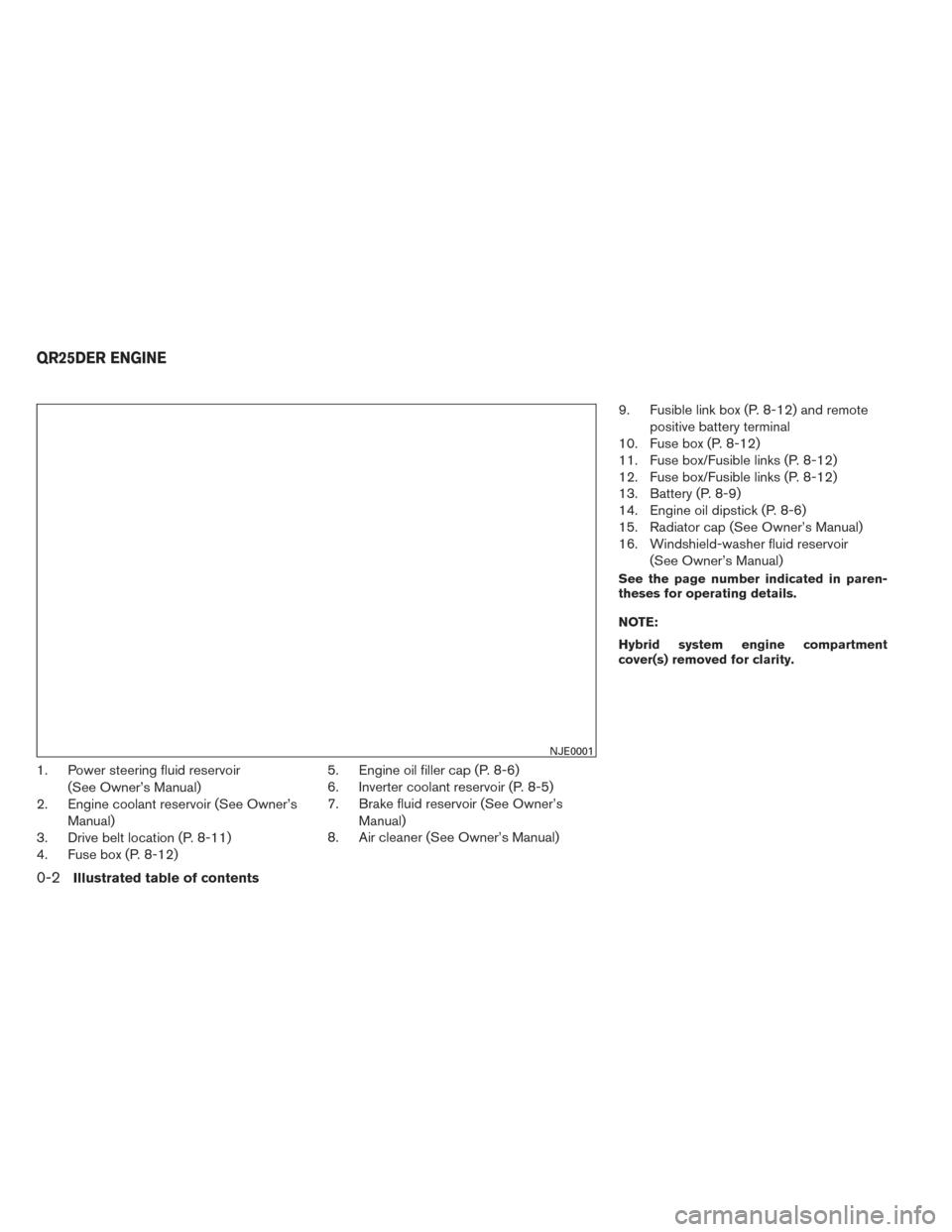
1. Power steering fluid reservoir(See Owner’s Manual)
2. Engine coolant reservoir (See Owner’s
Manual)
3. Drive belt location (P. 8-11)
4. Fuse box (P. 8-12) 5. Engine oil filler cap (P. 8-6)
6. Inverter coolant reservoir (P. 8-5)
7. Brake fluid reservoir (See Owner’s
Manual)
8. Air cleaner (See Owner’s Manual) 9. Fusible link box (P. 8-12) and remote
positive battery terminal
10. Fuse box (P. 8-12)
11. Fuse box/Fusible links (P. 8-12)
12. Fuse box/Fusible links (P. 8-12)
13. Battery (P. 8-9)
14. Engine oil dipstick (P. 8-6)
15. Radiator cap (See Owner’s Manual)
16. Windshield-washer fluid reservoir
(See Owner’s Manual)
See the page number indicated in paren-
theses for operating details.
NOTE:
Hybrid system engine compartment
cover(s) removed for clarity.
NJE0001
QR25DER ENGINE
0-2Illustrated table of contents
Page 59 of 571
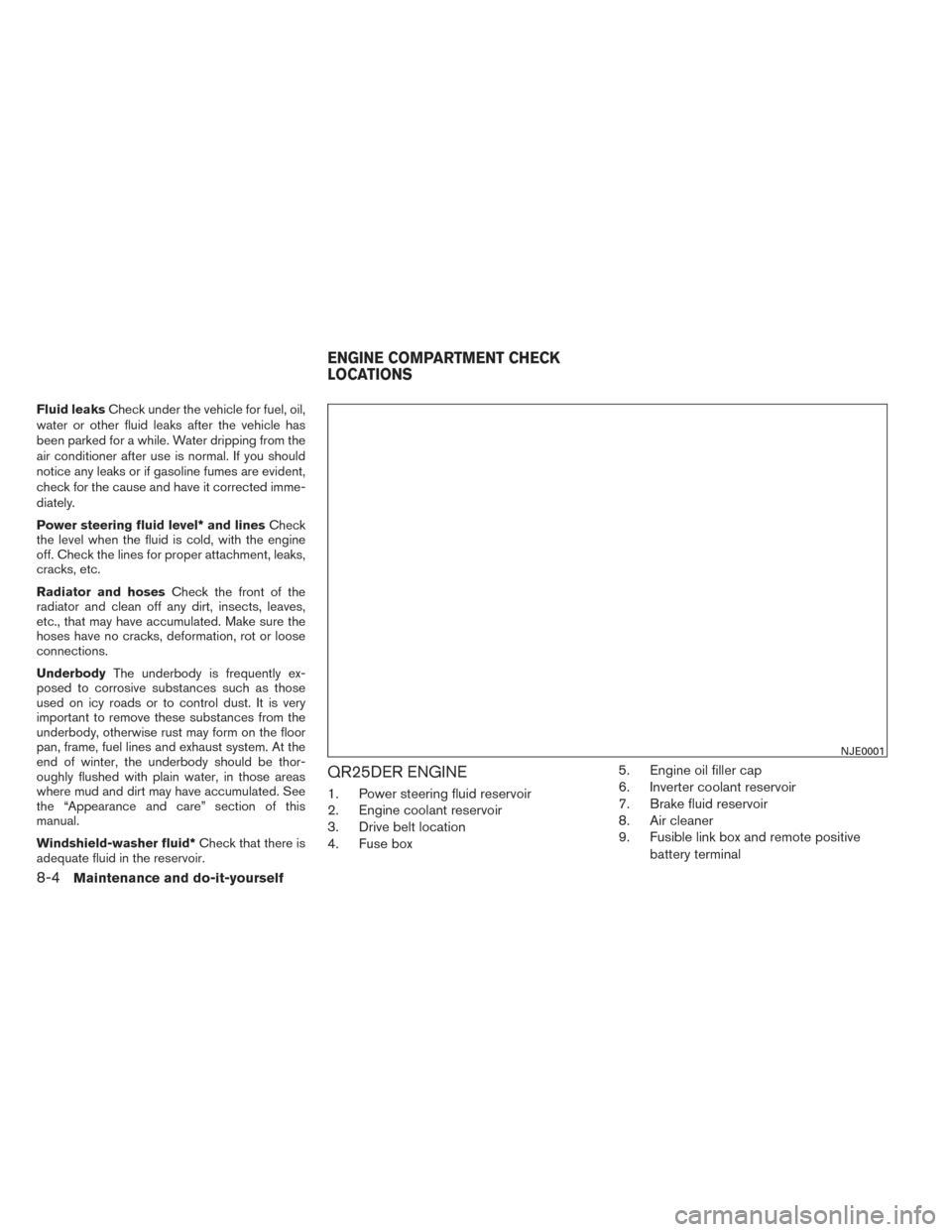
Fluid leaksCheck under the vehicle for fuel, oil,
water or other fluid leaks after the vehicle has
been parked for a while. Water dripping from the
air conditioner after use is normal. If you should
notice any leaks or if gasoline fumes are evident,
check for the cause and have it corrected imme-
diately.
Power steering fluid level* and lines Check
the level when the fluid is cold, with the engine
off. Check the lines for proper attachment, leaks,
cracks, etc.
Radiator and hoses Check the front of the
radiator and clean off any dirt, insects, leaves,
etc., that may have accumulated. Make sure the
hoses have no cracks, deformation, rot or loose
connections.
Underbody The underbody is frequently ex-
posed to corrosive substances such as those
used on icy roads or to control dust. It is very
important to remove these substances from the
underbody, otherwise rust may form on the floor
pan, frame, fuel lines and exhaust system. At the
end of winter, the underbody should be thor-
oughly flushed with plain water, in those areas
where mud and dirt may have accumulated. See
the “Appearance and care” section of this
manual.
Windshield-washer fluid* Check that there is
adequate fluid in the reservoir.
QR25DER ENGINE
1. Power steering fluid reservoir
2. Engine coolant reservoir
3. Drive belt location
4. Fuse box 5. Engine oil filler cap
6. Inverter coolant reservoir
7. Brake fluid reservoir
8. Air cleaner
9. Fusible link box and remote positive
battery terminal
NJE0001
ENGINE COMPARTMENT CHECK
LOCATIONS
8-4Maintenance and do-it-yourself
Page 60 of 571
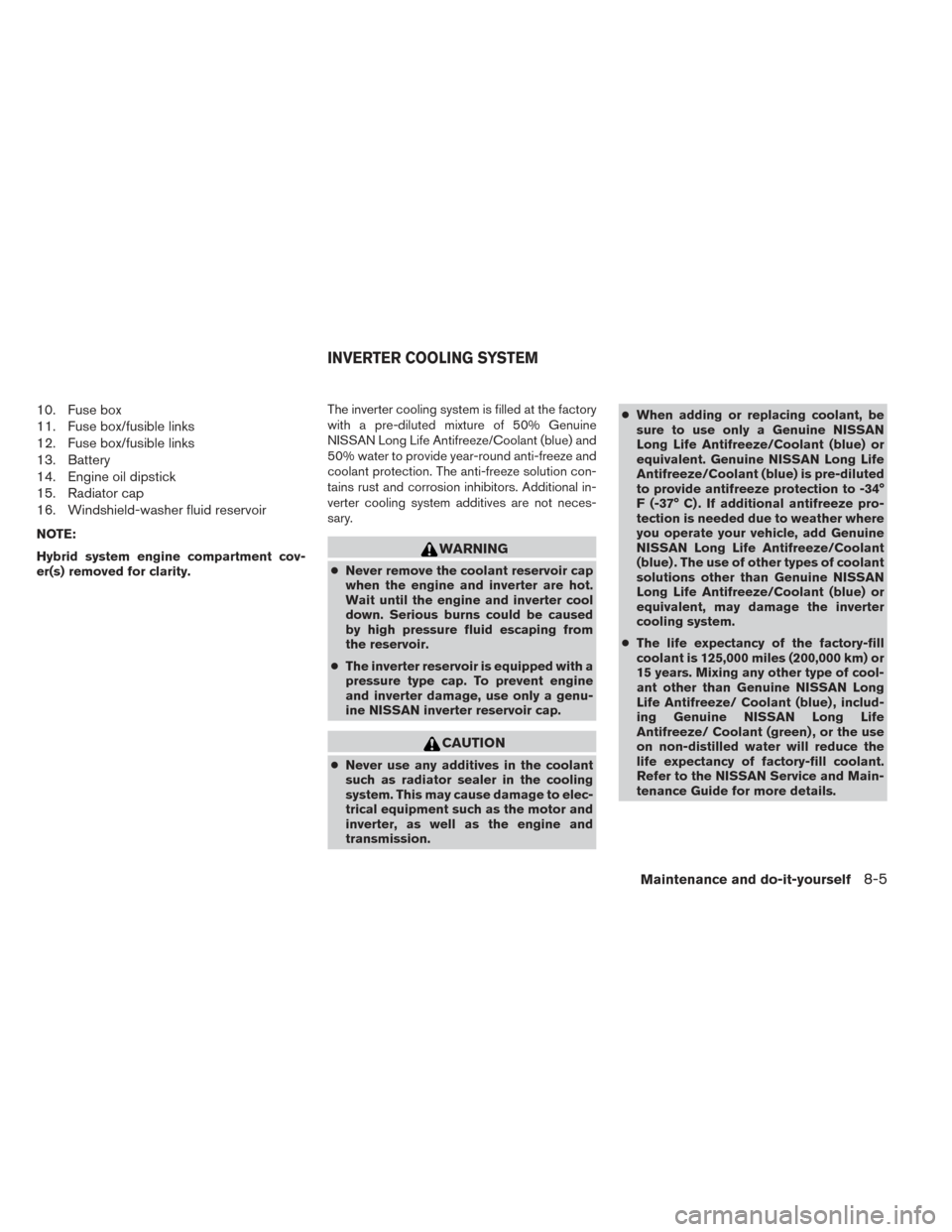
10. Fuse box
11. Fuse box/fusible links
12. Fuse box/fusible links
13. Battery
14. Engine oil dipstick
15. Radiator cap
16. Windshield-washer fluid reservoir
NOTE:
Hybrid system engine compartment cov-
er(s) removed for clarity.The inverter cooling system is filled at the factory
with a pre-diluted mixture of 50% Genuine
NISSAN Long Life Antifreeze/Coolant (blue) and
50% water to provide year-round anti-freeze and
coolant protection. The anti-freeze solution con-
tains rust and corrosion inhibitors. Additional in-
verter cooling system additives are not neces-
sary.WARNING
●
Never remove the coolant reservoir cap
when the engine and inverter are hot.
Wait until the engine and inverter cool
down. Serious burns could be caused
by high pressure fluid escaping from
the reservoir.
● The inverter reservoir is equipped with a
pressure type cap. To prevent engine
and inverter damage, use only a genu-
ine NISSAN inverter reservoir cap.
CAUTION
● Never use any additives in the coolant
such as radiator sealer in the cooling
system. This may cause damage to elec-
trical equipment such as the motor and
inverter, as well as the engine and
transmission. ●
When adding or replacing coolant, be
sure to use only a Genuine NISSAN
Long Life Antifreeze/Coolant (blue) or
equivalent. Genuine NISSAN Long Life
Antifreeze/Coolant (blue) is pre-diluted
to provide antifreeze protection to -34°
F (-37° C) . If additional antifreeze pro-
tection is needed due to weather where
you operate your vehicle, add Genuine
NISSAN Long Life Antifreeze/Coolant
(blue) . The use of other types of coolant
solutions other than Genuine NISSAN
Long Life Antifreeze/Coolant (blue) or
equivalent, may damage the inverter
cooling system.
● The life expectancy of the factory-fill
coolant is 125,000 miles (200,000 km) or
15 years. Mixing any other type of cool-
ant other than Genuine NISSAN Long
Life Antifreeze/ Coolant (blue) , includ-
ing Genuine NISSAN Long Life
Antifreeze/ Coolant (green) , or the use
on non-distilled water will reduce the
life expectancy of factory-fill coolant.
Refer to the NISSAN Service and Main-
tenance Guide for more details.
INVERTER COOLING SYSTEM
Maintenance and do-it-yourself8-5
Page 67 of 571

ENGINE COMPARTMENT
CAUTION
Never use a fuse of a higher or lower
amperage rating than specified on the
fuse box cover. This could damage the
electrical system or cause a fire.
If any electrical equipment does not come on,
check for an open fuse. 1. Be sure the ignition switch and the headlight switch are OFF.
2. Open the engine hood. 3. Remove the fuse box cover by pushing the
tab and lifting the cover up.
4. Remove the fuse with the fuse puller. The fuse puller is located in the fuse block in the
passenger compartment.
NJE0004
8-12Maintenance and do-it-yourself
Page 94 of 571
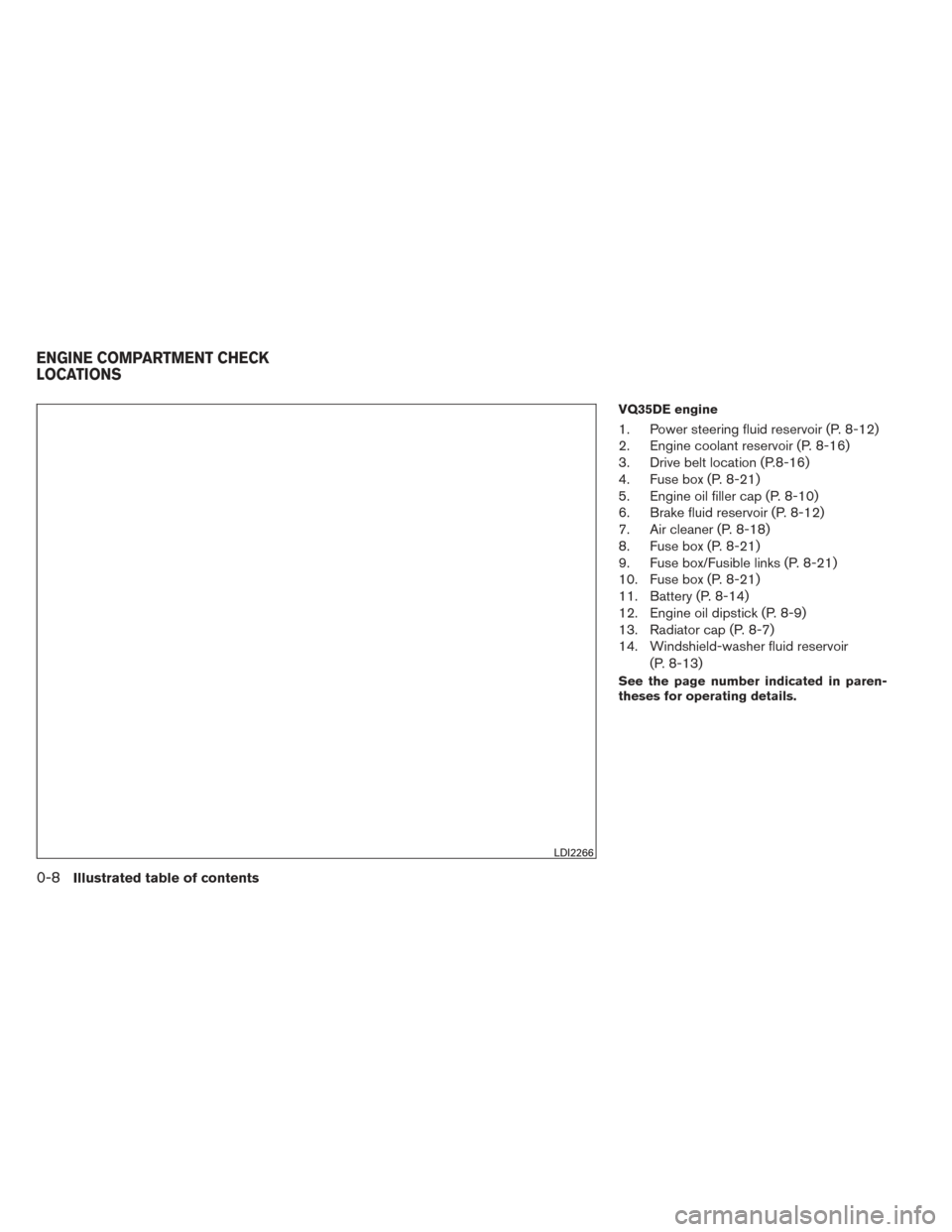
VQ35DE engine
1. Power steering fluid reservoir (P. 8-12)
2. Engine coolant reservoir (P. 8-16)
3. Drive belt location (P.8-16)
4. Fuse box (P. 8-21)
5. Engine oil filler cap (P. 8-10)
6. Brake fluid reservoir (P. 8-12)
7. Air cleaner (P. 8-18)
8. Fuse box (P. 8-21)
9. Fuse box/Fusible links (P. 8-21)
10. Fuse box (P. 8-21)
11. Battery (P. 8-14)
12. Engine oil dipstick (P. 8-9)
13. Radiator cap (P. 8-7)
14. Windshield-washer fluid reservoir(P. 8-13)
See the page number indicated in paren-
theses for operating details.
LDI2266
ENGINE COMPARTMENT CHECK
LOCATIONS
0-8Illustrated table of contents
Page 208 of 571
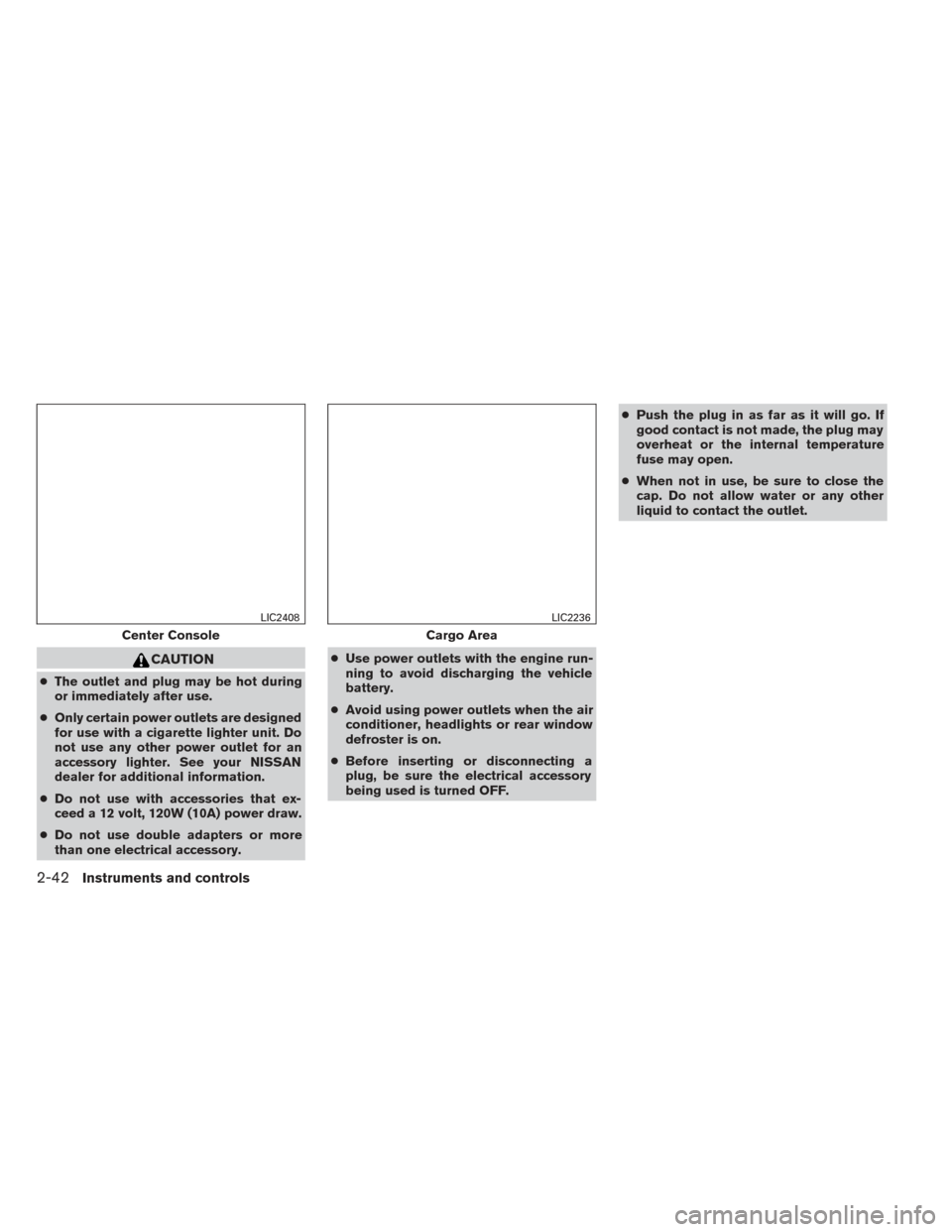
CAUTION
●The outlet and plug may be hot during
or immediately after use.
● Only certain power outlets are designed
for use with a cigarette lighter unit. Do
not use any other power outlet for an
accessory lighter. See your NISSAN
dealer for additional information.
● Do not use with accessories that ex-
ceed a 12 volt, 120W (10A) power draw.
● Do not use double adapters or more
than one electrical accessory. ●
Use power outlets with the engine run-
ning to avoid discharging the vehicle
battery.
● Avoid using power outlets when the air
conditioner, headlights or rear window
defroster is on.
● Before inserting or disconnecting a
plug, be sure the electrical accessory
being used is turned OFF. ●
Push the plug in as far as it will go. If
good contact is not made, the plug may
overheat or the internal temperature
fuse may open.
● When not in use, be sure to close the
cap. Do not allow water or any other
liquid to contact the outlet.
Center Console
LIC2408
Cargo Area
LIC2236
2-42Instruments and controls
Page 209 of 571
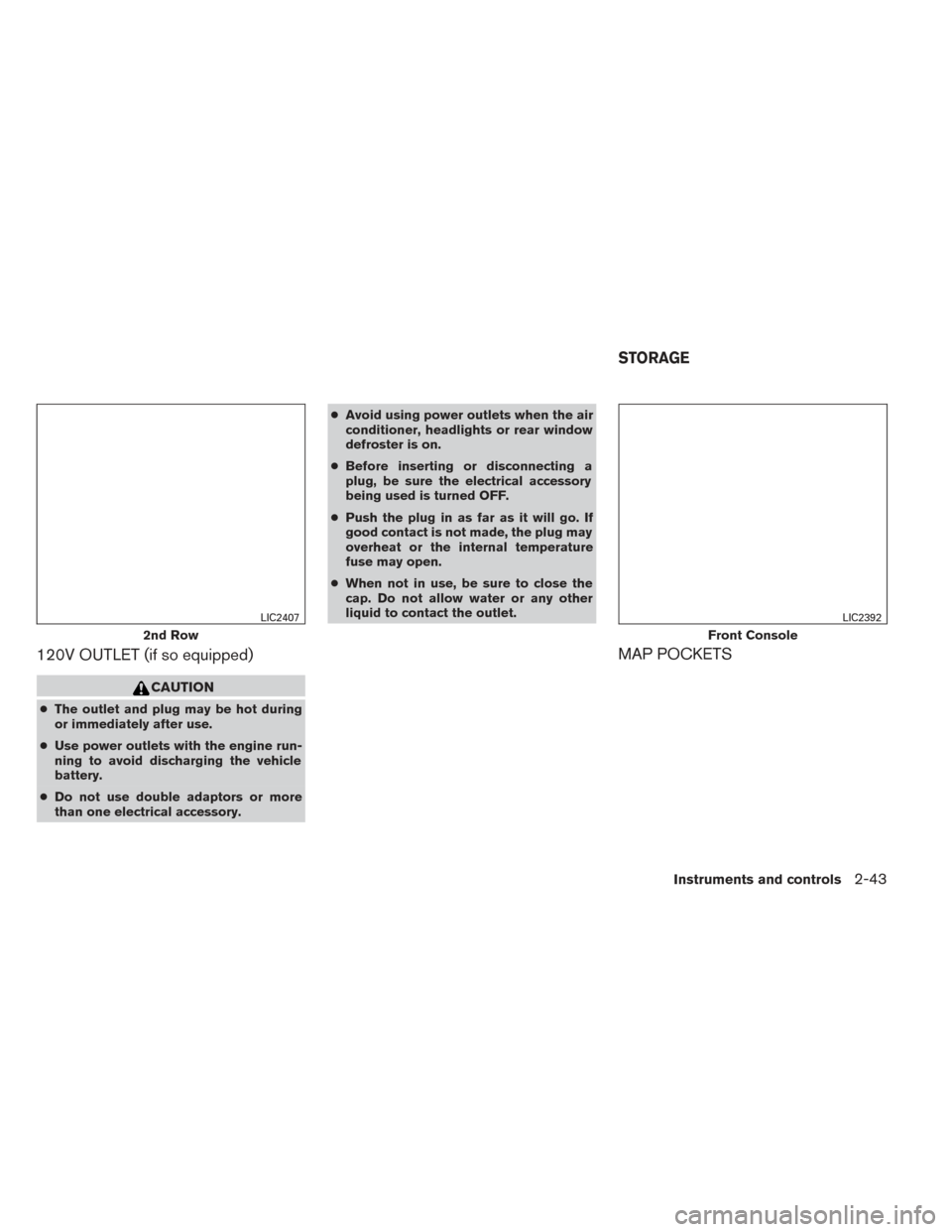
120V OUTLET (if so equipped)
CAUTION
●The outlet and plug may be hot during
or immediately after use.
● Use power outlets with the engine run-
ning to avoid discharging the vehicle
battery.
● Do not use double adaptors or more
than one electrical accessory. ●
Avoid using power outlets when the air
conditioner, headlights or rear window
defroster is on.
● Before inserting or disconnecting a
plug, be sure the electrical accessory
being used is turned OFF.
● Push the plug in as far as it will go. If
good contact is not made, the plug may
overheat or the internal temperature
fuse may open.
● When not in use, be sure to close the
cap. Do not allow water or any other
liquid to contact the outlet.
MAP POCKETS
2nd Row
LIC2407
Front Console
LIC2392
STORAGE
Instruments and controls2-43
Page 267 of 571
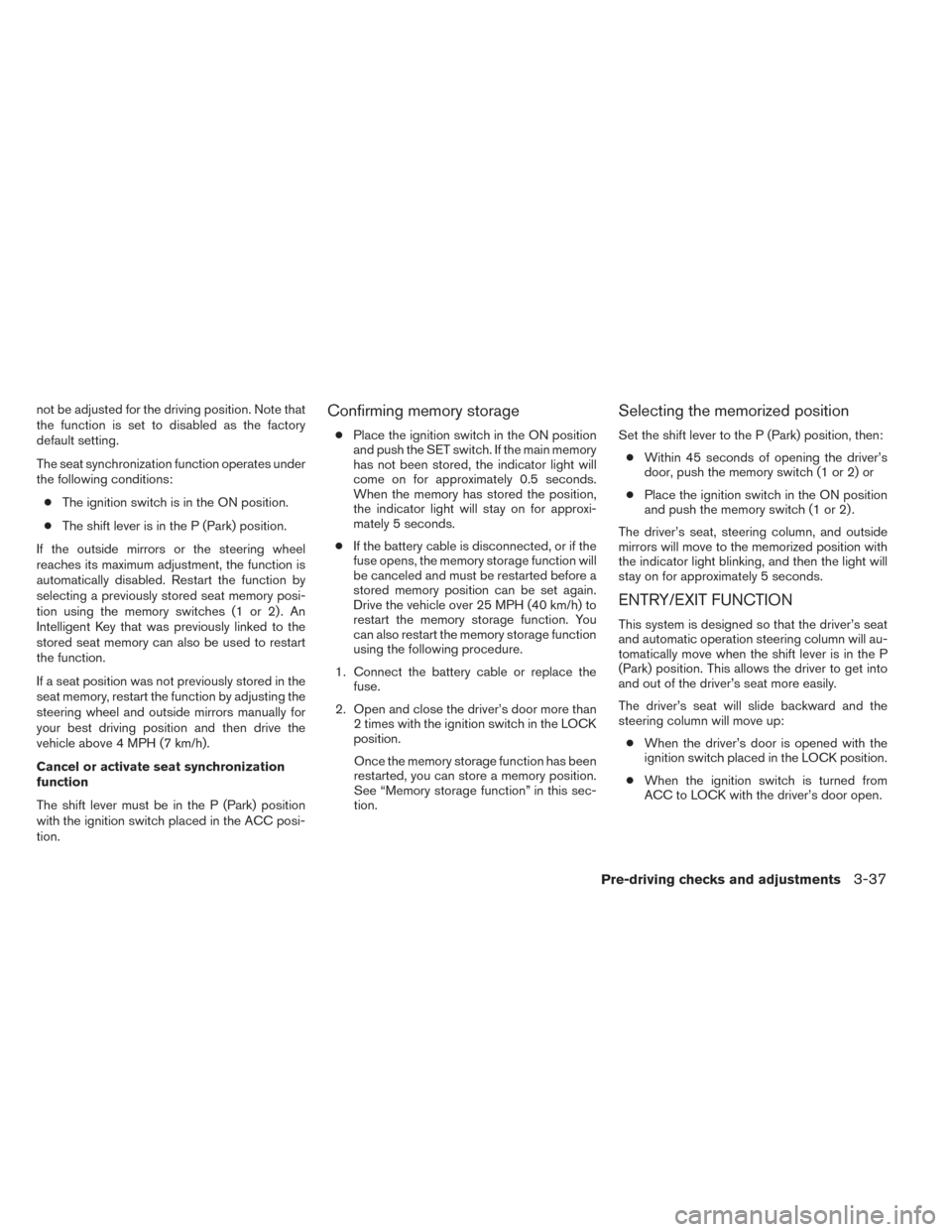
not be adjusted for the driving position. Note that
the function is set to disabled as the factory
default setting.
The seat synchronization function operates under
the following conditions:● The ignition switch is in the ON position.
● The shift lever is in the P (Park) position.
If the outside mirrors or the steering wheel
reaches its maximum adjustment, the function is
automatically disabled. Restart the function by
selecting a previously stored seat memory posi-
tion using the memory switches (1 or 2) . An
Intelligent Key that was previously linked to the
stored seat memory can also be used to restart
the function.
If a seat position was not previously stored in the
seat memory, restart the function by adjusting the
steering wheel and outside mirrors manually for
your best driving position and then drive the
vehicle above 4 MPH (7 km/h).
Cancel or activate seat synchronization
function
The shift lever must be in the P (Park) position
with the ignition switch placed in the ACC posi-
tion.Confirming memory storage
● Place the ignition switch in the ON position
and push the SET switch. If the main memory
has not been stored, the indicator light will
come on for approximately 0.5 seconds.
When the memory has stored the position,
the indicator light will stay on for approxi-
mately 5 seconds.
● If the battery cable is disconnected, or if the
fuse opens, the memory storage function will
be canceled and must be restarted before a
stored memory position can be set again.
Drive the vehicle over 25 MPH (40 km/h) to
restart the memory storage function. You
can also restart the memory storage function
using the following procedure.
1. Connect the battery cable or replace the fuse.
2. Open and close the driver’s door more than 2 times with the ignition switch in the LOCK
position.
Once the memory storage function has been
restarted, you can store a memory position.
See “Memory storage function” in this sec-
tion.
Selecting the memorized position
Set the shift lever to the P (Park) position, then: ● Within 45 seconds of opening the driver’s
door, push the memory switch (1 or 2) or
● Place the ignition switch in the ON position
and push the memory switch (1 or 2) .
The driver’s seat, steering column, and outside
mirrors will move to the memorized position with
the indicator light blinking, and then the light will
stay on for approximately 5 seconds.
ENTRY/EXIT FUNCTION
This system is designed so that the driver’s seat
and automatic operation steering column will au-
tomatically move when the shift lever is in the P
(Park) position. This allows the driver to get into
and out of the driver’s seat more easily.
The driver’s seat will slide backward and the
steering column will move up: ● When the driver’s door is opened with the
ignition switch placed in the LOCK position.
● When the ignition switch is turned from
ACC to LOCK with the driver’s door open.
Pre-driving checks and adjustments3-37